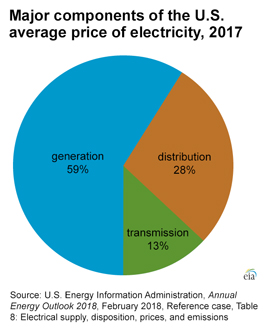Did you know?
The cost of generating electricity is the largest component of the price of electricity.
Did you know?
The cost to supply electricity actually varies minute by minute.
During the course of a single day, the wholesale price of electricity on the electric power grid reflects the real-time cost for supplying electricity. Demand for electricity contributes to the cost of supplying electricity. Electricity demand is usually highest in the afternoon and early evening (peak hours), and costs to provide electricity are usually higher at these times.
Most consumers pay prices based on the seasonal average cost of providing electricity, so they do not experience these daily price fluctuations. Some utilities offer their customers time-of-day pricing to encourage electricity conservation and to reduce peak demand for electricity.
Many factors influence electricity prices
Electricity prices generally reflect the cost to build, finance, maintain, and operate power plants and the electricity grid (the complex system of power transmission and distribution lines). Some for-profit utilities also include a financial return for owners and shareholders in their electricity prices.
Several key factors influence the price of electricity:
- Fuels: Fuel costs can vary, especially during periods of high demand. High electricity demand can increase demand for fuel, such as natural gas, which can result in higher prices for the fuel and, in turn, higher costs to generate electricity.
- Power plants: Each power plant has construction, maintenance, and operating costs.
- Transmission and distribution system: The electricity transmission and distribution systems that deliver electricity have maintenance costs, which include repairing damage to the systems from accidents or extreme weather conditions.
- Weather conditions: Rain and snow provide water for low-cost hydropower generation. Wind can provide low-cost electricity generation from wind turbines when wind speeds are favorable. However, extreme temperatures can increase the demand for electricity, especially for cooling, and demand can drive prices up.
- Regulations: In some states, public service/utility commissions fully regulate prices, while other states have a combination of unregulated prices (for generators) and regulated prices (for transmission and distribution).
Electricity prices are usually highest in the summer
The cost to supply electricity actually changes minute by minute. However, most consumers pay rates based on the seasonal cost of electricity. Changes in prices generally reflect variations in electricity demand, availability of generation sources, fuel costs, and power plant availability. Prices are usually highest in the summer when total demand is high because more expensive generation sources are added to meet the increased demand.
Electricity prices vary by type of customer
Electricity prices are usually highest for residential and commercial consumers because it costs more to distribute electricity to them. Industrial consumers use more electricity and can receive it at higher voltages, so supplying electricity to these customers is more efficient and less expensive. The price of electricity to industrial customers is generally close to the wholesale price of electricity.
In 2017, the annual average price of electricity in the United States was about 10.54¢ per kilowatthour (kWh). The annual average prices by major types of utility customers were
- Residential: 12.90¢ per kWh
- Commercial: 10.68¢ per kWh
- Industrial: 6.91¢ per kWh
- Transportation: 9.67¢ per kWh
Electricity prices vary by locality
Prices vary by locality because of the availability of power plants and fuels, local fuel costs, and pricing regulations. In 2017, annual average electricity prices ranged from approximately 26.07¢ per kWh in Hawaii to about 7.75¢ per kWh in Louisiana.




